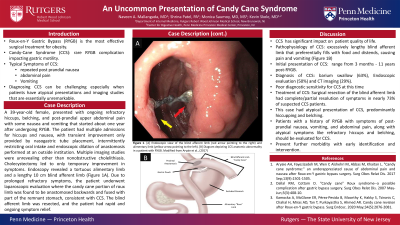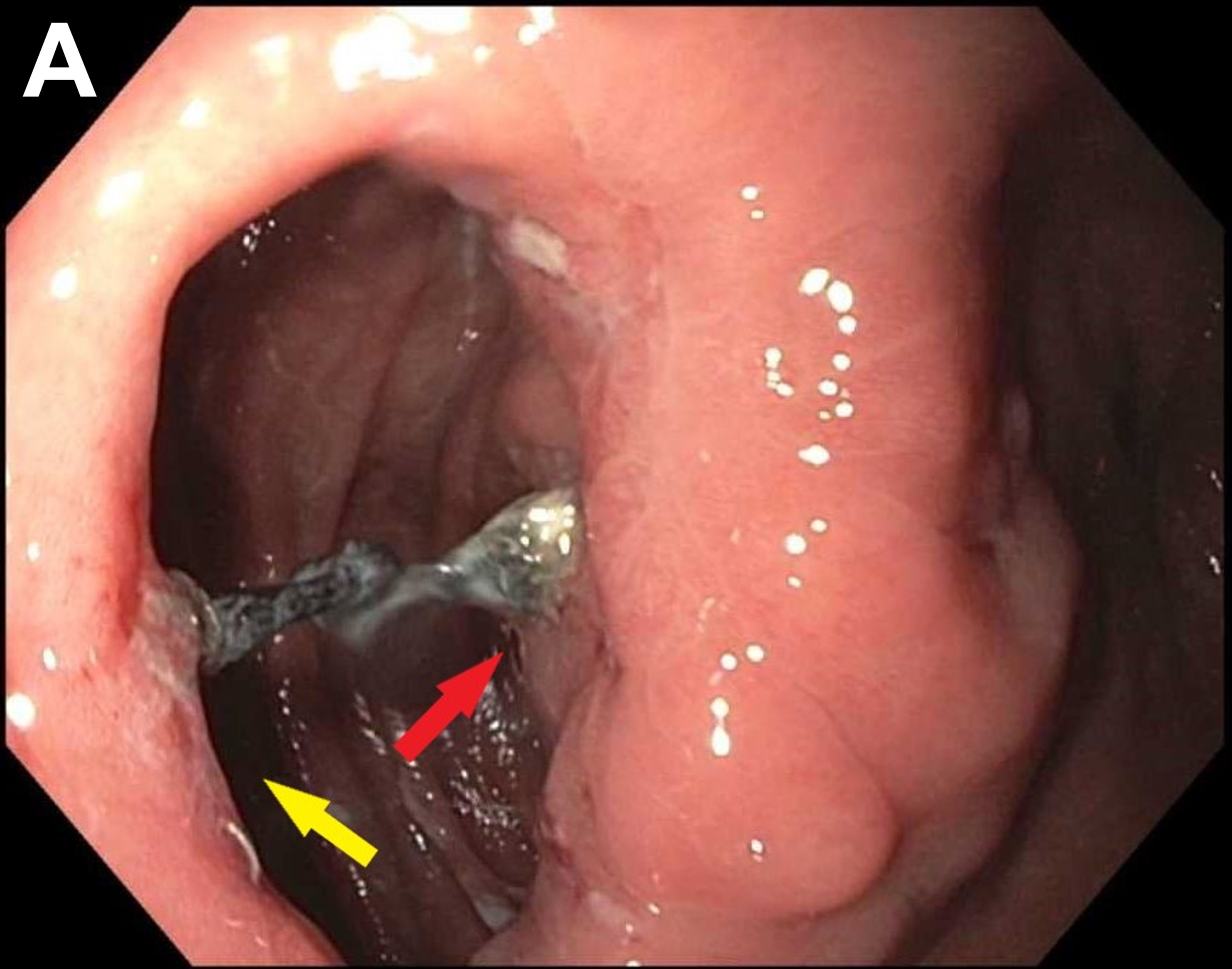Sunday Poster Session
Category: General Endoscopy
P0569 - An Uncommon Presentation of Candy Cane Syndrome
Sunday, October 22, 2023
3:30 PM - 7:00 PM PT
Location: Exhibit Hall

Has Audio

Naveen Mallangada, MD
Rutgers Robert Wood Johnson Medical School
New Brunswick, NJ
Presenting Author(s)
Award: Presidential Poster Award
Naveen Mallangada, MD1, Shrina Patel, PA-C2, Monica Saumoy, MD, MS2, Kevin Skole, MD3
1Rutgers Robert Wood Johnson Medical School, New Brunswick, NJ; 2Penn Medicine-Princeton Physicians, Center for Digestive Health, Plainsboro, NJ; 3Rutgers Robert Wood Johnson Medical School/Penn Medicine-Princeton Physicians, Center for Digestive Health, Plainsboro, NJ
Introduction: Roux-en-Y Gastric Bypass (RYGB) is one of the most effective surgical treatments for obesity. A rare complication is Candy-Cane Syndrome (CCS) impacting gastric motility and causing repeated episodes of post-prandial nausea, abdominal pain, and vomiting. Diagnosing CCS can be challenging, especially when patients have atypical presentations and imaging studies that are essentially unremarkable.
Case Description/Methods: A 39-year-old female presented with ongoing refractory hiccups, belching, and post-prandial upper abdominal pain with some nausea and vomiting that started about one year after undergoing RYGB. The patient had multiple admissions for hiccups and nausea, with transient improvement only provided by nasogastric tube placement and intermittent oral intake restriction. Multiple imaging studies were unrevealing, other than non-obstructive cholelithiasis. Cholecystectomy led to only temporary improvement in symptoms. Endoscopy (EGD) revealed a tortuous alimentary limb and a 10 cm blind afferent limb (Image A). CCS was suspected, and the patient underwent laparoscopic evaluation where the “candy cane portion” of the alimentary limb was found to be anastomosed backwards and fused with part of the remnant stomach. The blind afferent limb was resected, and the patient had rapid and ongoing symptom relief.
Discussion: CCS is an uncommon but notable complication of RYGB, as it has a significant impact on a patient’s quality of life. The pathophysiology of CCS is presumed to be secondary to an excessively long blind afferent limb that preferentially distends with food instead of transiting food through the alimentary limb, leading to significant pain and excessive vomiting. Initial presentation of CCS can range from 3 months to 11 years post-RYGB. Positive CCS diagnosis is best found via barium swallow (63%), followed by EGD (50%) and Computerized Tomography (29%). Without highly sensitive methods of diagnosis, clinical suspicion is necessary in atypical CCS presentations. In an observational trial, 73% of patients with suspected CCS had complete or partial resolution of symptoms after surgical resection of the blind afferent limb.
In conclusion, patients with prior RYGB having ongoing symptoms of post-prandial nausea, vomiting, and abdominal pain, along with atypical symptoms like refractory hiccups and belching, should be evaluated for CCS. Evaluation of CCS is best performed via barium swallow and EGD evaluation, with surgical resection providing immediate and sustained symptom relief.

Disclosures:
Naveen Mallangada, MD1, Shrina Patel, PA-C2, Monica Saumoy, MD, MS2, Kevin Skole, MD3. P0569 - An Uncommon Presentation of Candy Cane Syndrome, ACG 2023 Annual Scientific Meeting Abstracts. Vancouver, BC, Canada: American College of Gastroenterology.
Naveen Mallangada, MD1, Shrina Patel, PA-C2, Monica Saumoy, MD, MS2, Kevin Skole, MD3
1Rutgers Robert Wood Johnson Medical School, New Brunswick, NJ; 2Penn Medicine-Princeton Physicians, Center for Digestive Health, Plainsboro, NJ; 3Rutgers Robert Wood Johnson Medical School/Penn Medicine-Princeton Physicians, Center for Digestive Health, Plainsboro, NJ
Introduction: Roux-en-Y Gastric Bypass (RYGB) is one of the most effective surgical treatments for obesity. A rare complication is Candy-Cane Syndrome (CCS) impacting gastric motility and causing repeated episodes of post-prandial nausea, abdominal pain, and vomiting. Diagnosing CCS can be challenging, especially when patients have atypical presentations and imaging studies that are essentially unremarkable.
Case Description/Methods: A 39-year-old female presented with ongoing refractory hiccups, belching, and post-prandial upper abdominal pain with some nausea and vomiting that started about one year after undergoing RYGB. The patient had multiple admissions for hiccups and nausea, with transient improvement only provided by nasogastric tube placement and intermittent oral intake restriction. Multiple imaging studies were unrevealing, other than non-obstructive cholelithiasis. Cholecystectomy led to only temporary improvement in symptoms. Endoscopy (EGD) revealed a tortuous alimentary limb and a 10 cm blind afferent limb (Image A). CCS was suspected, and the patient underwent laparoscopic evaluation where the “candy cane portion” of the alimentary limb was found to be anastomosed backwards and fused with part of the remnant stomach. The blind afferent limb was resected, and the patient had rapid and ongoing symptom relief.
Discussion: CCS is an uncommon but notable complication of RYGB, as it has a significant impact on a patient’s quality of life. The pathophysiology of CCS is presumed to be secondary to an excessively long blind afferent limb that preferentially distends with food instead of transiting food through the alimentary limb, leading to significant pain and excessive vomiting. Initial presentation of CCS can range from 3 months to 11 years post-RYGB. Positive CCS diagnosis is best found via barium swallow (63%), followed by EGD (50%) and Computerized Tomography (29%). Without highly sensitive methods of diagnosis, clinical suspicion is necessary in atypical CCS presentations. In an observational trial, 73% of patients with suspected CCS had complete or partial resolution of symptoms after surgical resection of the blind afferent limb.
In conclusion, patients with prior RYGB having ongoing symptoms of post-prandial nausea, vomiting, and abdominal pain, along with atypical symptoms like refractory hiccups and belching, should be evaluated for CCS. Evaluation of CCS is best performed via barium swallow and EGD evaluation, with surgical resection providing immediate and sustained symptom relief.

Figure: Endoscopic view of the blind afferent limb (red arrow pointing to the right) and the alimentary limb (yellow arrow pointing to the left).
Disclosures:
Naveen Mallangada indicated no relevant financial relationships.
Shrina Patel indicated no relevant financial relationships.
Monica Saumoy indicated no relevant financial relationships.
Kevin Skole indicated no relevant financial relationships.
Naveen Mallangada, MD1, Shrina Patel, PA-C2, Monica Saumoy, MD, MS2, Kevin Skole, MD3. P0569 - An Uncommon Presentation of Candy Cane Syndrome, ACG 2023 Annual Scientific Meeting Abstracts. Vancouver, BC, Canada: American College of Gastroenterology.

